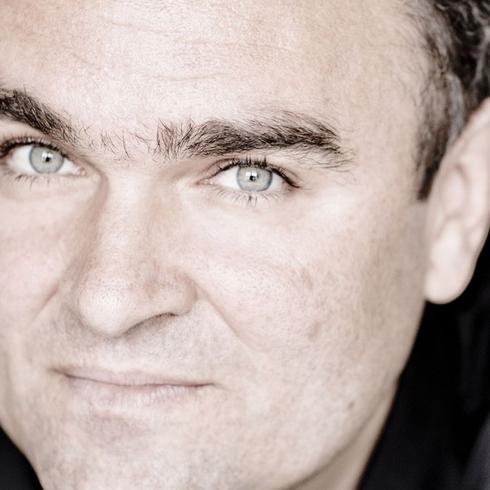© Marco Borggreve
Jörg Widmann studied the clarinet at the Hochschule für Musik in Munich with Gerd Starke and Charles Neidich at the Juilliard School in New York (1994-1995). He additionally took composition lessons with Kay Westermann, Wilfried Hiller and Hans Werner Henze (1994-1996) and later Heiner Goebbels and Wolfgang Rihm in Karlsruhe (1997-1999). As a clarinettist, he regularly performs with Daniel Barenboim, Tabea Zimmermann, Heinz Holliger, András Schiff, Kim Kashkashian, and Hélène Grimaud.
Several works have been dedicated to Widmann by fellow composers: in 1999, he performed the premiere ofMusic for Clarinet and Orchestra by Wolfgang Rihm in the musica viva concert series; in 2006, he performed Cantusby Aribert Reimann with the WDR symphony orchestra, and in 2009, at the Lucerne Festival, the world premiere of Rechant by Heinz Holliger. From 2001 to 2015, Widmann was professor of clarinet at the Freiburg Staatliche Hochschule für Musik where he also took up the post of professor of composition in 2009. From 2017, he holds a chair at the Barenboim-Said-Academy in Berlin. Moreover, Widmann is Pricipal Conductor of the Irish Chamber Orchestra.
It is the string quartets which form the core of Widmann’s œuvre : String Quartet No. I (1997), followed by Choralquartett (2003/2006) and Jagdquartett which was premiered by the Arditti Quartet in 2003. This series was completed in 2005 by String Quartet No. IV (first performance given by the Vogler Quartet) and Quartet No. V with soprano, Versuch über die Fuge [Attempt at a Fugue], premiered by Juliane Banse and the Artemis Quartet. The five string quartets are intended as a large cycle, with each individual work following a traditional form of setting.
Widmann has composed a trilogy of works for large orchestra on the transformation of vocal forms for instrumental forces consisting of the compositions Lied (2003/2007), Chor (2004) and Messe (2005). A second trilogy comprises the pieces Labyrinth (2005), Zweites Labyrinth (2006), Drittes
Labyrinth (2013/2014). In 2007, Christian Tetzlaff and the Junge Deutsche Philharmonie gave the premiere of Widmann’s first Violin Concerto. The same year, Pierre Boulez and the Vienna Philharmonic gave the first performance of Armonica for orchestra. Con brio, an homage to Beethoven, performed for the first time by the Bavarian Radio Symphony Orchestra under the direction of Mariss Jansons. For pianist Yefim Bronfman, Widmann wrote the piano concerto Trauermarsch. It was first performed in December 2014 with the Berlin Philharmonic under the baton of Sir Simon Rattle. Premiered in November 2015 by the Orchestre de Paris and soloist Antoine Tamestit, Widmann's Viola Concerto uniquely explores the Sound possibilities of the Instrument as does the Violin Concerto No. 2 for Carolin Widmann, written and premiered in 2018.
Music-theatre projects are premiered : the opera Das Gesicht im Spiegel (2003/04), Am Anfang( 2009) was premiered by Widmann and the visual artist Anselm Kiefer on the occasion of the 20th anniversary of the Opéra Bastille in Paris and also Babylon (2011/12) with a new version commissioned by the Staatsoper Unter den Linden, Berlin in 2019. His oratorio ARCHE (2016) for the opening of Hamburg’s was premiered by Kent Nagano and the Philharmonisches Staatsorchester Hamburg in January 2017.
Jörg Widmann has received numerous prizes – among them - the Belmont Prize for Contemporary Music from the Forberg-Schneider Foundation (1998), the Arnold Schönberg Prize (2004), the Music Award of the Heidelberger Frühling and the GEMA German Music Authors Award. In 2018, he was awarded the Robert Schumann Award of the Academy of Sciences and Literature Mainz and the Bayerischer Maximiliansorden für Wissenschaft und Kunst. He is a fellow of the Institute for Advanced Study in Berlin and a full member of the Bavarian Academy of Fine Arts, the Free Academy of the Arts in Hamburg, the German Academy of Dramatic Arts and the Academy of Sciences and Literature Mainz. He was composer-in-residence of the Deutsches Symphonie-Orchester Berlin, the Cleveland Orchestra, the Salzburg Festival, the Lucerne Festival, the Cologne Philharmonic Orchestra, and the Vienna Konzerthaus.


